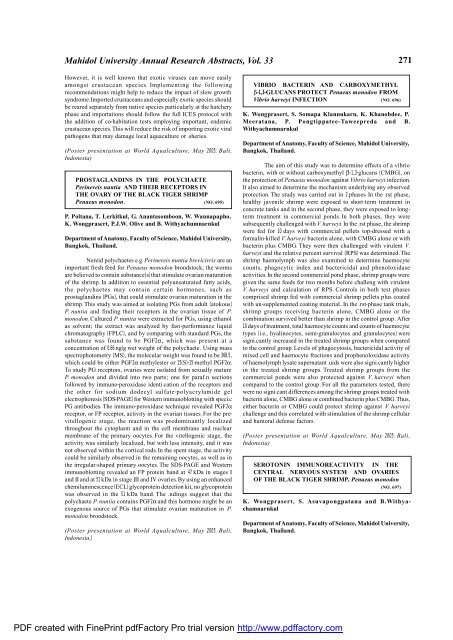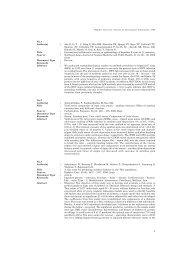Faculty of Science - Mahidol University
Faculty of Science - Mahidol University
Faculty of Science - Mahidol University
You also want an ePaper? Increase the reach of your titles
YUMPU automatically turns print PDFs into web optimized ePapers that Google loves.
<strong>Mahidol</strong> <strong>University</strong> Annual Research Abstracts, Vol. 33 271<br />
However, it is well known that exotic viruses can move easily<br />
amongst crustacean species. Implementing the following<br />
recommendations might help to reduce the impact <strong>of</strong> slow growth<br />
syndrome. Imported crustaceans and especially exotic species should<br />
be reared separately from native species particularly at the hatchery<br />
phase and importations should follow the full ICES protocol with<br />
the addition <strong>of</strong> co-habitation tests employing important, endemic<br />
crustacean species. This will reduce the risk <strong>of</strong> importing exotic viral<br />
pathogens that may damage local aquaculture or .sheries.<br />
(Poster presentation at World Aqualculture, May 2005. Bali,<br />
Indonesia)<br />
PROSTAGLANDINS IN THE POLYCHAETE<br />
Perinereis nuntia AND THEIR RECEPTORS IN<br />
THE OVARY OF THE BLACK TIGER SHRIMP<br />
Penaeus monodon. (NO. 695)<br />
P. Poltana, T. Lerkitkul, G. Anantasomboon, W. Wannapapho,<br />
K. Wongprasert, P.J.W. Olive and B. Withyachumnarnkul<br />
Department <strong>of</strong> Anatomy, <strong>Faculty</strong> <strong>of</strong> <strong>Science</strong>, <strong>Mahidol</strong> <strong>University</strong>,<br />
Bangkok, Thailand.<br />
Nereid polychaetes e.g. Perinereis nuntia brevicirris are an<br />
important fresh feed for Penaeus monodon broodstock; the worms<br />
are believed to contain substance(s) that stimulate ovarian maturation<br />
<strong>of</strong> the shrimp. In addition to essential polyunsaturated fatty acids,<br />
the polychaetes may contain certain hormones, such as<br />
prostaglandins (PGs), that could stimulate ovarian maturation in the<br />
shrimp. This study was aimed at isolating PGs from adult (atokous)<br />
P. nuntia and finding their receptors in the ovarian tissue <strong>of</strong> P.<br />
monodon. Cultured P. nuntia were extracted for PGs, using ethanol<br />
as solvent; the extract was analyzed by fast-performance liquid<br />
chromatography (FPLC), and by comparing with standard PGs, the<br />
substance was found to be PGF2α, which was present at a<br />
concentration <strong>of</strong> 0.66 ng/g wet weight <strong>of</strong> the polychaete. Using mass<br />
spectrophotometry (MS), the molecular weight was found to be 368.5,<br />
which could be either PGF2α methylester or 15(S)-15-methyl PGF2α.<br />
To study PG receptors, ovaries were isolated from sexually mature<br />
P. monodon and divided into two parts; one for paraf.n sections<br />
followed by immuno-peroxidase identi.cation <strong>of</strong> the receptors and<br />
the other for sodium dodecyl sulfate-polyacrylamide gel<br />
electrophoresis (SDS-PAGE) for Western immunoblotting with speci.c<br />
PG antibodies. The immuno-peroxidase technique revealed PGF2α<br />
receptor, or FP receptor, activity in the ovarian tissues. For the previtellogenic<br />
stage, the reaction was predominantly localized<br />
throughout the cytoplasm and in the cell membrane and nuclear<br />
membrane <strong>of</strong> the primary oocytes. For the vitellogenic stage, the<br />
activity was similarly localized, but with less intensity, and it was<br />
not observed within the cortical rods. In the spent stage, the activity<br />
could be similarly observed in the remaining oocytes, as well as in<br />
the irregular-shaped primary oocytes. The SDS-PAGE and Western<br />
immunoblotting revealed an FP protein band at 47 kDa in stages I<br />
and II and at 51 kDa in stage III and IV ovaries. By using an enhanced<br />
chemiluminescence (ECL) glycoprotein detection kit, no glycoprotein<br />
was observed in the 51 kDa band. The .ndings suggest that the<br />
polychaete P. nuntia contains PGF2α and this hormone might be an<br />
exogenous source <strong>of</strong> PGs that stimulate ovarian maturation in P.<br />
monodon broodstock.<br />
(Poster presentation at World Aqualculture, May 2005. Bali,<br />
Indonesia.)<br />
VIBRIO BACTERIN AND CARBOXYMETHYL<br />
b-1,3-GLUCANS PROTECT Penaeus monodon FROM<br />
Vibrio harveyi INFECTION (NO. 696)<br />
K. Wongprasert, S. Somapa Klannukarn, K. Khanobdee, P.<br />
Meeratana, P. Pongtippatee-Taweepreda and B.<br />
Withyachumnarnkul<br />
Department <strong>of</strong> Anatomy, <strong>Faculty</strong> <strong>of</strong> <strong>Science</strong>, <strong>Mahidol</strong> <strong>University</strong>,<br />
Bangkok, Thailand.<br />
The aim <strong>of</strong> this study was to determine effects <strong>of</strong> a vibrio<br />
bacterin, with or without carboxymethyl β-1,3-glucans (CMBG), on<br />
the protection <strong>of</strong> Penaeus monodon against Vibrio harveyi infection.<br />
It also aimed to determine the mechanism underlying any observed<br />
protection. The study was carried out in 2 phases. In the .rst phase,<br />
healthy juvenile shrimp were exposed to short-term treatment in<br />
concrete tanks and in the second phase, they were exposed to long -<br />
term treatment in commercial ponds. In both phases, they were<br />
subsequently challenged with V. harveyi. In the .rst phase, the shrimp<br />
were fed for 10 days with commercial pellets top-dressed with a<br />
formalin-killed V. harveyi bacterin alone, with CMBG alone or with<br />
bacterin plus CMBG. They were then challenged with virulent V.<br />
harveyi and the relative percent survival (RPS) was determined. The<br />
shrimp haemolymph was also examined to determine haemocyte<br />
counts, phagocytic index and bactericidal and phenoloxidase<br />
activities. In the second commercial pond phase, shrimp groups were<br />
given the same feeds for two months before challeng with virulent<br />
V. harveyi and calculation <strong>of</strong> RPS. Controls in both test phases<br />
comprised shrimp fed with commercial shrimp pellets plus coated<br />
with un-supplemented coating material.. In the .rst-phase tank trials,<br />
shrimp groups receiving bacterin alone, CMBG alone or the<br />
combination survived better than shrimp in the control group . After<br />
10 days <strong>of</strong> treatment, total haemocyte counts and counts <strong>of</strong> haemocyte<br />
types (i.e., hyalinocytes, semi-granulocytes and granulocytes) were<br />
signi.cantly increased in the treated shrimp groups when compared<br />
to the control group. Levels <strong>of</strong> phagocytosis, bactericidal activity <strong>of</strong><br />
mixed cell and haemocyte fractions and prophenoloxidase activity<br />
<strong>of</strong> haemolymph lysate supernatant .uids were also signi.cantly higher<br />
in the treated shrimp groups. Treated shrimp groups from the<br />
commercial ponds were also protected against V. harveyi when<br />
compared to the control group . For all the parameters tested, there<br />
were no signi.cant differences among the shrimp groups treated with<br />
bacterin alone, CMBG alone or combined bacterin plus CMBG. Thus,<br />
either bacterin or CMBG could protect shrimp against V. harveyi<br />
challenge and this correlated with stimulation <strong>of</strong> the shrimp cellular<br />
and humoral defense factors.<br />
(Poster presentation at World Aqualculture, May 2005. Bali,<br />
Indonesia)<br />
SEROTONIN IMMUNOREACTIVITY IN THE<br />
CENTRAL NERVOUS SYSTEM AND OVARIES<br />
OF THE BLACK TIGER SHRIMP, Penaeus monodon<br />
(NO. 697)<br />
K. Wongprasert, S. Asuvapongpatana and B.Withyachamnarnkul<br />
Department <strong>of</strong> Anatomy, <strong>Faculty</strong> <strong>of</strong> <strong>Science</strong>, <strong>Mahidol</strong> <strong>University</strong>,<br />
Bangkok, Thailand.<br />
PDF created with FinePrint pdfFactory Pro trial version http://www.pdffactory.com
















